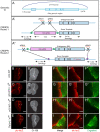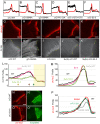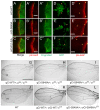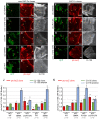Drosophila hedgehog can act as a morphogen in the absence of regulated Ci processing
- PMID: 33084577
- PMCID: PMC7679133
- DOI: 10.7554/eLife.61083
Drosophila hedgehog can act as a morphogen in the absence of regulated Ci processing
Abstract
Extracellular Hedgehog (Hh) proteins induce transcriptional changes in target cells by inhibiting the proteolytic processing of full-length Drosophila Ci or mammalian Gli proteins to nuclear transcriptional repressors and by activating the full-length Ci or Gli proteins. We used Ci variants expressed at physiological levels to investigate the contributions of these mechanisms to dose-dependent Hh signaling in Drosophila wing imaginal discs. Ci variants that cannot be processed supported a normal pattern of graded target gene activation and the development of adults with normal wing morphology, when supplemented by constitutive Ci repressor, showing that Hh can signal normally in the absence of regulated processing. The processing-resistant Ci variants were also significantly activated in the absence of Hh by elimination of Cos2, likely acting through binding the CORD domain of Ci, or PKA, revealing separate inhibitory roles of these two components in addition to their well-established roles in promoting Ci processing.
Keywords: Ci; D. melanogaster; Protein Kinase A; cell biology; costal 2; developmental biology; hedgehog; morphogen; signaling.
Plain language summary
Morphogens play a crucial role in determining how cells are organized in developing organisms. These chemical signals act over a wide area, and the amount of signal each cell receives typically initiates a sequence of events that spatially pattern the multiple cells of an organ or tissue. One of the most well-studied groups of morphogens are the hedgehog proteins, which are involved in the development of many animals, ranging from flies to humans. In fruit flies, hedgehog proteins kickstart a cascade of molecular changes that switch on a set of 'target' genes. They do this by ultimately altering the activity of a protein called cubitus interruptus, which comes in two lengths: a long version called Ci-155 and a short version called Ci-75. When hedgehog is absent, Ci-155 is kept in an inactive state in the cytoplasm, where it is slowly converted into its shorter form, Ci-75: this repressor protein is then able to access the nucleus, where it switches ‘off’ the target genes. However, when a hedgehog signal is present, the processing of Ci into its shorter form is inhibited. Instead, Ci-155 becomes activated by a separate mechanism that allows the long form protein to enter the nucleus and switch ‘on’ the target genes. But it was unclear whether hedgehog requires both of these mechanisms in order to act as a morphogen and regulate the activity of developmental genes. To answer this question, Little et al. mutated the gene for Ci in the embryo of fruit flies, so that the Ci-155 protein could no longer be processed into Ci-75. Examining the developing wings of these flies revealed that the genes targeted by hedgehog are still activated in the correct pattern. In some parts of the wing, Ci-75 is required to switch off specific sets of genes. But when Little et al. blocked these genes, by adding a gene that constantly produces the Ci repressor in the presence or absence of hedgehog, the adult flies still developed normally structured wings. This suggests that hedgehog does not need to regulate the processing of Ci-155 into Ci-75 in order to perform its developmental role. Previous work showed that when one of the major mechanisms used by hedgehog to activate Ci-155 is blocked, fruit flies are still able to develop normal wings. Taken together with the findings of Little et al., this suggests that the two mechanisms induced by hedgehog can compensate for each other, and independently regulate the development of the fruit fly wing. These mechanisms, which are also found in humans, have been linked to birth defects and several common types of cancer, and understanding how they work could help the development of new treatments.
© 2020, Little et al.
Conflict of interest statement
JL, EG, AS, DK No competing interests declared
Figures











Similar articles
-
Su(fu) switches Rdx functions to fine-tune hedgehog signaling in the Drosophila wing disk.Genes Cells. 2013 Jan;18(1):66-78. doi: 10.1111/gtc.12018. Epub 2012 Dec 6. Genes Cells. 2013. PMID: 23216924
-
Hedgehog-stimulated phosphorylation at multiple sites activates Ci by altering Ci-Ci interfaces without full Suppressor of Fused dissociation.PLoS Biol. 2025 Apr 11;23(4):e3003105. doi: 10.1371/journal.pbio.3003105. eCollection 2025 Apr. PLoS Biol. 2025. PMID: 40215228 Free PMC article.
-
Hedgehog-regulated Costal2-kinase complexes control phosphorylation and proteolytic processing of Cubitus interruptus.Dev Cell. 2005 Feb;8(2):267-78. doi: 10.1016/j.devcel.2005.01.001. Dev Cell. 2005. PMID: 15691767
-
Regulation of Hedgehog signaling: a complex story.Biochem Pharmacol. 2004 Mar 1;67(5):805-14. doi: 10.1016/j.bcp.2004.01.002. Biochem Pharmacol. 2004. PMID: 15104233 Free PMC article. Review.
-
Decoding Ci: from partial degradation to inhibition.Dev Growth Differ. 2015 Feb;57(2):98-108. doi: 10.1111/dgd.12187. Epub 2014 Dec 14. Dev Growth Differ. 2015. PMID: 25495033 Review.
Cited by
-
SPOP and CUL3 Modulate the Sonic Hedgehog Signal Response Through Controlled Degradation of GLI Family Transcription Factors.Front Cell Dev Biol. 2021 Jul 30;9:710295. doi: 10.3389/fcell.2021.710295. eCollection 2021. Front Cell Dev Biol. 2021. PMID: 34395437 Free PMC article. Review.
-
Gli Phosphorylation Code in Hedgehog Signal Transduction.Front Cell Dev Biol. 2022 Jan 25;10:846927. doi: 10.3389/fcell.2022.846927. eCollection 2022. Front Cell Dev Biol. 2022. PMID: 35186941 Free PMC article. Review.
-
Regulation of somatic stem cell and niche precursor fates and proliferation of by Wnt, JAK-STAT, Hedgehog and Hippo/Yorkie pathways during Drosophila pupal ovary development resembles the signaling framework organizing adult stem cell behavior.bioRxiv [Preprint]. 2025 May 13:2025.05.08.652870. doi: 10.1101/2025.05.08.652870. bioRxiv. 2025. PMID: 40463270 Free PMC article. Preprint.
-
Physiological analysis of the mechanism of Ci transcription factor activation through multiple Fused phosphorylation sites in Hedgehog signal transduction.bioRxiv [Preprint]. 2025 Jan 25:2025.01.24.634727. doi: 10.1101/2025.01.24.634727. bioRxiv. 2025. PMID: 39896583 Free PMC article. Preprint.
-
Dose-dependent phosphorylation and activation of Hh pathway transcription factors.Life Sci Alliance. 2022 Sep 5;5(11):e202201570. doi: 10.26508/lsa.202201570. Print 2022 Nov. Life Sci Alliance. 2022. PMID: 36271509 Free PMC article.
References
-
- Blair SS. Engrailed expression in the anterior lineage compartment of the developing wing blade of Drosophila. Development. 1992;115:21–33. - PubMed
Publication types
MeSH terms
Substances
Grants and funding
LinkOut - more resources
Full Text Sources
Molecular Biology Databases

